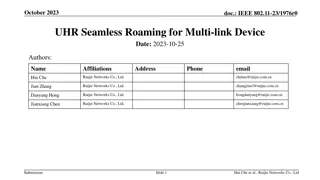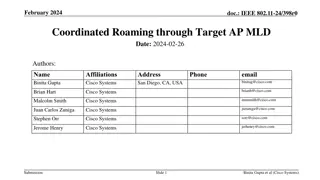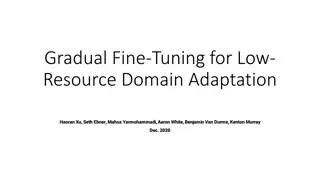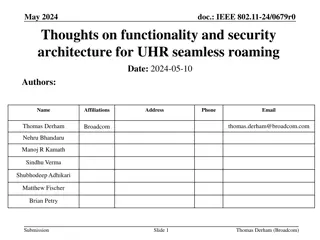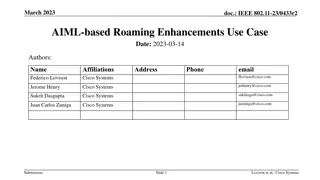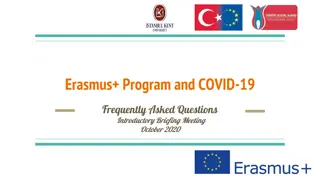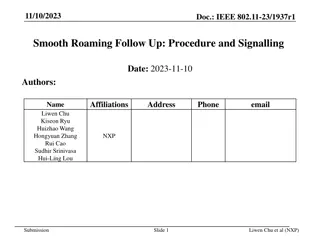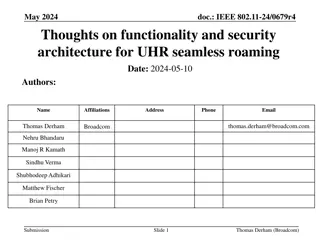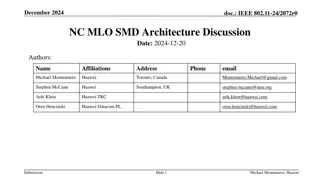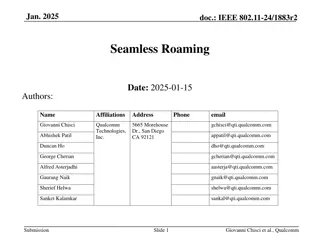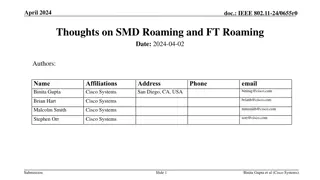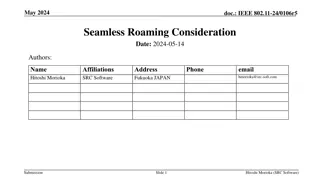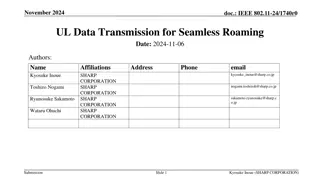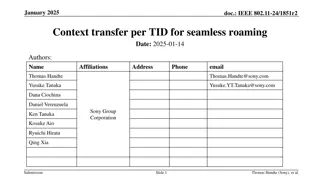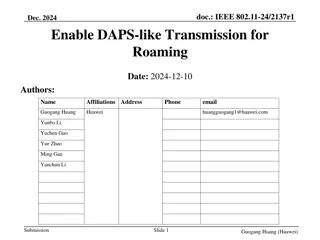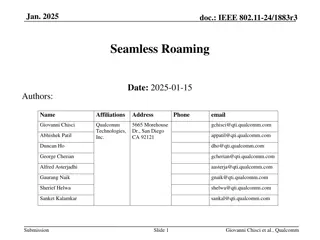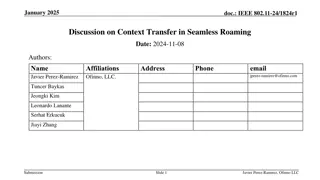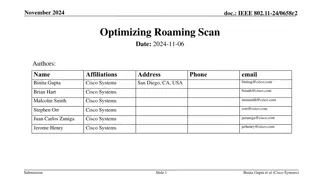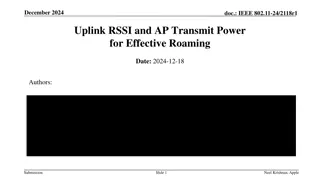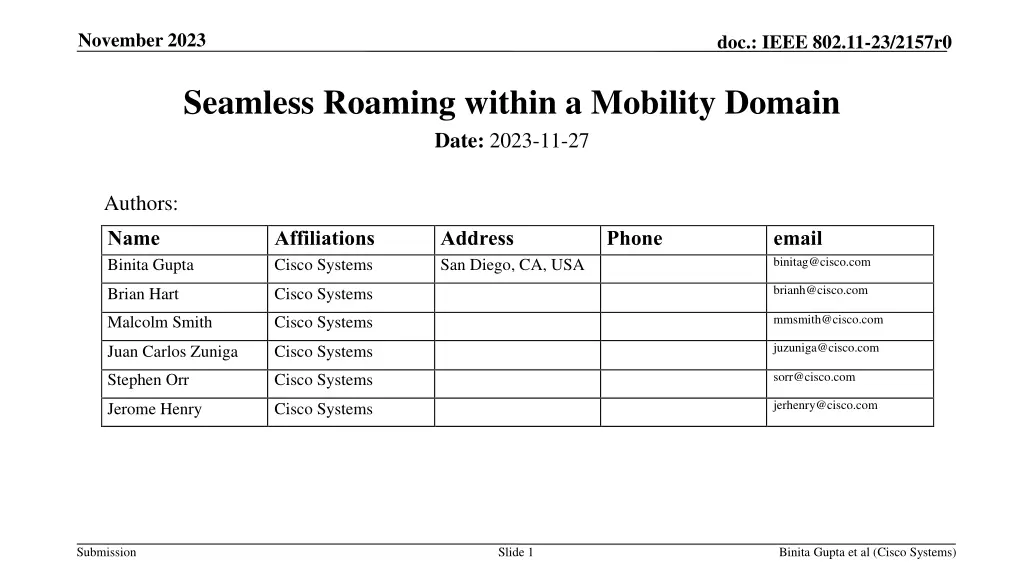
Seamless Roaming Architecture Details
Explore the proposed seamless roaming architecture, signaling, and data path operations for enhanced roaming performance within a mobility domain as discussed in IEEE document IEEE 802.11-23/2157r0. The presentation expands on various architecture options presented, such as Mandatory 11k/v/r, Elongated Client Connectivity, Hot Standby, and Distributed MLO, each with unique characteristics affecting frame loss, complexity, and client behavior.
Download Presentation

Please find below an Image/Link to download the presentation.
The content on the website is provided AS IS for your information and personal use only. It may not be sold, licensed, or shared on other websites without obtaining consent from the author. If you encounter any issues during the download, it is possible that the publisher has removed the file from their server.
You are allowed to download the files provided on this website for personal or commercial use, subject to the condition that they are used lawfully. All files are the property of their respective owners.
The content on the website is provided AS IS for your information and personal use only. It may not be sold, licensed, or shared on other websites without obtaining consent from the author.
E N D
Presentation Transcript
November 2023 doc.: IEEE 802.11-23/2157r0 Seamless Roaming within a Mobility Domain Date: 2023-11-27 Authors: Name Binita Gupta Affiliations Cisco Systems Address San Diego, CA, USA Phone email binitag@cisco.com brianh@cisco.com Brian Hart Cisco Systems mmsmith@cisco.com Malcolm Smith Cisco Systems juzuniga@cisco.com Juan Carlos Zuniga Cisco Systems sorr@cisco.com Stephen Orr Cisco Systems jerhenry@cisco.com Jerome Henry Cisco Systems Submission Slide 1 Binita Gupta et al (Cisco Systems)
November 2023 doc.: IEEE 802.11-23/2157r0 Introduction UHR PAR requires improved support for roaming. More reliable roaming mechanisms have been discussed in UHR to achieve seamless roaming [3][4]. Multiple architecture options for seamless roaming data path handling were presented in [1]. In this presentation, we expand on [1] and propose further details on roaming architecture, signaling and data path operation for seamless roaming. Submission Slide 2 Binita Gupta et al (Cisco Systems)
November 2023 doc.: IEEE 802.11-23/2157r0 Recap (1) In [1] four architecture options were captured for seamless roaming: Option A - Mandatory 11k/v/r: Mandate support for existing 11k/v/r features. This can achieve best case roaming time of 5-10 msec, but most clients don't achieve that, and there can be brief data loss. Goal is to achieve better roaming performance in 11bn. Option B - Elongated Client Connectivity: AP MLD1 (source) and AP MLD2 (target) minimize the transferred context. Only control plane context is transferred without any data transfer. Client drains DL buffered data from the old AP MLD before it completely switches to the target AP MLD. The knife-switch is at the client. Option C - Hot Standby: AP MLD1 (source) and AP MLD2 (target) exchange all context one time including both control plane context and data (one or more of MSDUs/A-MSDUs/MPDUs). Infrastructure switches the DS data path to target AP MLD after context transfer. The knife-switch is within the infrastructure. Option D: Distributed MLO: UMAC MLO operation is distributed across lower UMACs on AP MLD1 (source) and AP MLD2 (target) and an Upper UMAC which provides single data path interface to DS across AP MLDs. The Upper UMAC provides Roaming MLD functionalities [4] [5] and could reside on one of the AP MLDs or on another network node (e.g. controller). Separate roaming of Upper UMAC would need to be supported as client roams, to minimize delays. Submission Slide 3 Binita Gupta et al (Cisco Systems)
November 2023 doc.: IEEE 802.11-23/2157r0 Recap (2) Summary of options: Option A Option B Option C Option D Mandatory 11k/v/r Elongated client connectivity Name Hot standby Distributed MLO Knife-switch Within infrastructure At client Within infrastructure None Frame loss upon roaming Typical but brief losses Rare DL & infrequent UL losses Rare losses No losses Infrastructure upper layer complexity N/A N/A N/A High AP complexity Very low Low Moderate High Client complexity Very low Low-Moderate Low Moderate Association / Security Client associates to the Mobility Domain (e.g. an ESS), with a single unicast key Submission Slide 4 Binita Gupta et al (Cisco Systems)
November 2023 doc.: IEEE 802.11-23/2157r0 Challenges with Roaming MLD Architecture (1) Distributed MLO architecture (Option D in [1]) using a Roaming MLD for seamless roaming is ill advised because it leads to additional delays and high complexity for infrastructure and chipset [2]. Splitting data path functionality across Upper UMAC and Lower UMAC residing on different nodes adds significant complexity for coordination across these nodes and adds delays. Advertising Roaming MLD with many non-collocated affiliated APs would lead to beacon bloating If Roaming MLD with Upper UMAC is hosted on one of the AP MLDs Leads to additional delays from Roaming MLD to non-collocated AP MLDs Requires a mechanism to roam the Roaming MLDitself closer to client s location for scalability and to minimize delays. This adds further complexity. Roaming MLD hosted at one of the AP MLDs AP Roaming MLD (Upper UMAC) TX RX AP MLD (Lower UMAC) AP MLD (Lower UMAC) Non-collocated AP MLDs AP AP AP AP Binita Gupta et al (Cisco Systems) Submission Slide 5
November 2023 doc.: IEEE 802.11-23/2157r0 Challenges with Roaming MLD Architecture (2) If Roaming MLD with Upper UMAC is hosted at a centralized node (e.g. controller) Leads to additional buffering of frames and adds delays from Roaming MLD to non-collocated AP MLDs. Typically, controller and AP MLDs sit far apart. Requires fast networking path between controller and all AP MLDs. Continuous data path coordination across controller and AP MLDs is challenging. Avoiding DL wireless duplication requires coordination between AP MLDs, adding additional delays. Implementing reorder buffers is challenging in terms of scalability. Requires massive throughput at controller with high client scale. Due to these challenges, we strongly discourage adopting a Roaming MLD architecture for seamless roaming in 11bn AP Roaming MLD (Upper UMAC) Roaming MLD hosted at a centralized network node RX: merge frames in reorder buffer and release de-duped & ordered frames + replay detection. TX: Define SN+PN, then send to one (or more) AP MLDs. AP MLD (Lower UMAC) AP MLD (Lower UMAC) Non-collocated AP MLDs AP AP AP AP Binita Gupta et al (Cisco Systems) Submission Slide 6
November 2023 doc.: IEEE 802.11-23/2157r0 Roaming within a Seamless Mobility Domain Instead, we propose to adopt a roaming architecture which enables seamless roaming within a Seamless Mobility Domain (SMD) using Option B, Option C or hybrid of the two [1] Achieve seamless roaming without complexity of Roaming MLD An SMD consists of multiple AP MLDs across which seamless roaming is supported. One SMD could cover all AP MLDs of an ESS or an ESS can have multiple SMDs. Each AP MLD maintains its own data path to DS and complete UMAC functionality resides on the AP MLD as in 11be. UMAC is not split into Upper & Lower UMAC on different entities Each SMD is uniquely identified in the network using a virtual MAC address (SMD MAC Address). An AP MLD is configured with the SMD that it belongs to. Affiliated APs advertise SMD info in beacons & probe responses. For seamless roaming, a client associates with the SMDthrough an AP MLD and establishes setup links. Client then adds/deletes links with AP MLDs as it roams within that SMD. DS Seamless Mobility Domain AP MLD 1 AP 1 AP MLD 2 AP 3 AP MLD 3 AP 2 AP 4 AP 5 AP 6 Client s initial association with SMD through AP MLD 1 STA 1 STA 2 Client adds links with AP MLD 2, while remaining associated with SMD Non-AP MLD 1 Client moves Binita Gupta et al (Cisco Systems) Submission Slide 7
November 2023 doc.: IEEE 802.11-23/2157r0 Association to a Seamless Mobility Domain Association procedure is enhanced to indicate association to an SMD by including an SMD IE. A single PTK is generated for association to an SMD. The SMD MAC Address is used in PTK generation to tie it to the SMD. After client s initial association with the SMD through an AP MLD, infrastructure facilitates PTK distribution on all AP MLDs of the SMD. PTK can be distributed right after association or fetched from a key storage by AP MLDs when roaming preparation is triggered. GTK for added links during roaming is provided to the STA as part of add link operation. AID space is per AP MLD. Target AP MLD assigns a new AID to the non-AP MLD during Add Link operation. Auth Server DS PTK distributed to AP MLDs within SMD Seamless Mobility Domain PTK generated AP MLD 1 AP MLD 2 AP MLD 3 AP 5 AP 1 AP 3 AP 2 AP 4 AP 6 Client s initial auth + association with SMD through AP MLD 1 STA 1 STA 2 PTK distribution within SMD Non-AP MLD 1 Client adds links with AP MLD 2, while remaining associated with SMD Client moves Submission Binita Gupta et al (Cisco Systems) Slide 8
November 2023 doc.: IEEE 802.11-23/2157r0 Considerations for Seamless Roaming (1) Support only MLD level roaming: Client roams all links to a neighbouring AP MLD In a non-roaming state, a non-AP MLD only has links setup with a single AP MLD and does not have links split across multiple AP MLDs, to avoid infra. complexity of multiple data paths to DS. Only during roaming transition, a non-AP MLD has link connectivity through multiple AP MLDs to achieve make-before-break roaming. Non-AP MLD has DL wireless connectivity through both source and target AP MLDs. Non-AP MLD always has UL wireless connectivity through a single AP MLD first with source and then with target. DS Seamless Mobility Domain AP MLD 2 AP 3 AP MLD 1 AP 1 AP 4 AP 2 STA 1 STA 2 STA 1 STA 2 STA 1 STA 2 Non-AP MLD 1 Non-AP MLD 1 Non-AP MLD 1 Client Client Client (Non-roaming state) (Non-roaming state) (roaming transition state) Client moves Binita Gupta et al (Cisco Systems) Submission Slide 9
November 2023 doc.: IEEE 802.11-23/2157r0 Considerations for Seamless Roaming (2) Roaming context transfer: context transfer can be done in two phases to achieve faster roaming time. 1. Roaming preparation phase: Triggers the start of roaming procedure. Prepares one or more neighboring APs for roaming by transferring near static contexts (e.g. STA capabilities, BA agreements, SCS + QoS Char., TWT, negotiated TTLM). No resources are reserved on neighboring APs in this phase. If near static contexts change during this phase, then Source AP transfers updated contexts to neighboring APs. Context may timeout on neighboring APs after certain roaming preparation period indicated to the client. AP keeps the context until the timeout and ages it out after. Roaming preparation can be initiated by the STA or the AP e.g. AP may want to do load balancing based on BSS Load of neighboring APs. Candidate Target AP STA Source AP 1. Roaming Notification (list of requested roaming target AP MLDs) 2. AP selects or amends candidate target AP MLDs 3. Transfer near static context to candidate target AP MLDs (No resource reservation) 4. Roaming Notification (list of candidate target AP MLDs) Step 1 is omitted in AP initiated roaming preparation Submission Slide 10 Binita Gupta et al (Cisco Systems)
November 2023 doc.: IEEE 802.11-23/2157r0 Considerations for Seamless Roaming (3) 2. Roaming execution phase: Started within the roaming preparation period if specified by source AP in the preparation phase. Client indicates the target AP MLD (should consider any AP recommendation if received) using Add Link from the candidate target AP MLDs list. Source AP attempts to reserve resources on the target AP MLD (client includes RSSI for target APs in Add Link). Client may indicate roaming is acceptable even if some or all resources can t be reserved Source AP transfers dynamic context (e.g. SN, PN) to target AP MLD and sends Add Link Response (with group keys and AID). Link with source AP is deleted after draining buffered DL data. Roaming execution can also be initiated by the AP by sending an Add Link Notification that recommends a target AP MLD. ML Reconfiguration framework can be used/extended to define signalling for roaming phases. STA Target AP Source AP 0. Roaming Add Link Notification 1. Roaming Add Link Request (selected target AP MLD links) 2. Reserve resources + dynamic context (SN, PN) transfer to target AP MLD Get group keys + AID from target AP MLD 3. Roaming Add Link Response Group keys + AID from target AP MLD 4. Roaming Delete Link Step 0 is used to initiate roaming execution by the AP Submission Slide 11 Binita Gupta et al (Cisco Systems)
November 2023 doc.: IEEE 802.11-23/2157r0 Considerations for Seamless Roaming (4) Data path switching: DS data path is switched from source to target AP MLD right after the dynamic context (e.g. SN, PN) is transferred to the target AP MLD and Add Link response is sent to the client. After Add Link response - client can exchange UL & DL data with the target AP MLD and UL switches to the target AP MLD. To avoid data loss, source AP MLD continues to try to drain DL buffered data (Option B in [1]) and client can remain connected to source AP MLD even after add link response. There are two DL wireless data path to the client from source and target AP MLDs during roaming transiiton. Data forwarding: Option C in [1] described support for data forwarding to target AP during roaming. However, transferring all buffered data (e.g. MSDUs/A-MSDUs/MDPUs) may be complex to implement - it is harder to take out and transfer MPDUs buffered deep in the hardware than transfer buffered MSDUs/A-MSDUs. AP may support the option of selected data forwarding (e.g. MSDUs/A-MSDUs/MPDUs for high-QoS TIDs) for fast roaming and to minimize data losses Data forwarding done during roaming (e.g. MSDUs/A-MSDUs/MPDUs for specific TIDs/ACs or SCS streams) can be negotiated between source AP MLD and the non-AP MLD. Source AP MLD tries to drain rest of the DL buffered data to the non-AP MLD (hybrid of Option B & C) Submission Slide 12 Binita Gupta et al (Cisco Systems)
November 2023 doc.: IEEE 802.11-23/2157r0 Roaming across SMDs of an ESS SMD based roaming is the main mechanism to provide seamless roaming in 11bn For deployments with non-contiguous Wi-Fi coverage for an ESS (e.g. two campus buildings), different SMDs can be defined for each contiguous coverage FT (Fast BSS Transition) can be used for roaming across two non-contiguous SMDs of an ESS We propose to mandate support for 11r/FT for UHR client STAs to achieve fast reassociation across non-contiguous coverage for an ESS. Campus building 1 Campus building 2 SSID x, FT MDID y, SMD z1 SSID x, FT MDID y, SMD z2 AP MLD 2 AP MLD 2 AP MLD 1 AP MLD 1 Client Client Client Client 11r/FT roaming across non-contiguous SMDs of same ESS Seamless roaming within SMD z1 Seamless roaming within SMD z2 Submission Slide 13 Binita Gupta et al (Cisco Systems)
November 2023 doc.: IEEE 802.11-23/2157r0 Summary (1) There are several challenges with Roaming MLD architecture Additional buffering, data path coordination issues across non-collocated Roaming MLD and AP MLDs, roaming of Roaming MLD itself, scalability concern additional delays, high infra and chipset complexity. We propose to support association to an SMD and adopt seamless roaming within a Seamless Mobility Domain (SMD) An SMD consists of multiple AP MLDs across which seamless roaming is supported A single SMD can be configured to cover all AP MLDs of an ESS or an ESS can have multiple SMDs configured Each AP MLD maintains its own connectivity to DS and includes complete UMAC functionality A single PTK is generated for association to an SMD and used across all AP MLDs of that SMD Submission Slide 14 Binita Gupta et al (Cisco Systems)
November 2023 doc.: IEEE 802.11-23/2157r0 Summary (2) We propose following considerations for seamless roaming: Support only MLD level roaming, no link level roaming support Roaming context transfer can be done in two phases to achieve faster roaming Roaming preparation phase:Prepares one or more neighboring APs in advance for roaming by transferring near static contexts (e.g. STA capabilities, BA agreements, SCS + QoS Char., TWT, negotiated TTLM etc.). Roaming execution phase: Reserves resources and transfers dynamic context (e.g. SN,PN) to target AP MLD and deletes link to the source AP MLD to complete roaming. ML Reconfiguration framework can be used/extended to define signalling for roaming phases. Roaming operation can be initiated by the non-AP MLD or by the source AP MLD Support delivery of DL buffered data from source AP MLD even after the DS data path has been switched to a target AP MLD to avoid data loss Support the option of selected data forwarding to target AP MLD (e.g. for high QoS traffic) per negotiation between the client and source AP MLD We propose to mandate support for 11r/FT for UHR client STAs to achieve fast roaming across non-contiguous SMDs of an ESS Submission Slide 15 Binita Gupta et al (Cisco Systems)
November 2023 doc.: IEEE 802.11-23/2157r0 SP1 Do you agree to define a mechanism in 11bn that enables UHR non-AP MLDs to roam across non-collocated AP MLDs without requiring reassociation and renegotiation of unicast encryption keys? Each AP MLD maintains its own MAC-SAP connectivity to the DS Each AP MLD supports complete UMAC functionality. UMAC is not split into Upper UMAC and Lower UMAC residing on different entities. Submission Slide 16 Binita Gupta et al (Cisco Systems)
November 2023 doc.: IEEE 802.11-23/2157r0 SP2 Do you agree to define a mechanism in 11bn that enables a UHR non-AP MLD to associate with a Seamless Mobility Domain (SMD) at initial association and support roaming across AP MLDs belonging to an SMD without requiring reassociation and renegotiation of unicast encryption keys? An SMD consists of one or more AP MLDs across which seamless roaming is supported. A single SMD can be configured to cover all AP MLDs of an ESS or multiple SMDs can be configured for an ESS. An AP MLD advertises information for configured SMD in Beacon and Probe responses of its affiliated APs Association procedure is enhanced to support association to an SMD A single PTK is generated for association to an SMD and used across all AP MLDs of that SMD Submission Slide 17 Binita Gupta et al (Cisco Systems)
November 2023 doc.: IEEE 802.11-23/2157r0 SP3 Do you agree to define a roaming mechanism in 11bn that requires a UHR non-AP MLD to roam all links to a neighbouring target AP MLD. In a non-roaming state, a non-AP MLD only maintains links with a single AP MLD and does not have links split across multiple AP MLDs. Only during roaming transition, a non-AP MLD can have DL wireless connectivity through both the source AP MLD and a target AP MLD. The non-AP MLD always has UL wireless connectivity through a single AP MLD. Submission Slide 18 Binita Gupta et al (Cisco Systems)
November 2023 doc.: IEEE 802.11-23/2157r0 SP4 Do you agree to define a roaming mechanism in 11bn that supports context transfer during roaming operation in two phases as defined below. Roaming preparation phase:Prepare one or more candidate AP MLDs for roaming in advance by transferring near static contexts to those AP MLDs. Details of near static context is TBD. For example, near static context could include STA capabilities, BA agreements, SCS with QoS Characteristics agreements, TWT agreements and/or negotiated TTLM. Roaming execution phase: Reserve resources on a single target AP MLD, transfer dynamic context to that target AP MLD and delete link with the source AP MLD to complete roaming. Details of dynamic context is TBD. For example, dynamic context could include SN and PN. Submission Slide 19 Binita Gupta et al (Cisco Systems)
November 2023 doc.: IEEE 802.11-23/2157r0 SP5 Do you agree to define a roaming mechanism in 11bn that enables a non-AP MLD or its serving AP MLD to initiate the roaming operation? Submission Slide 20 Binita Gupta et al (Cisco Systems)
November 2023 doc.: IEEE 802.11-23/2157r0 SP6 Do you agree to reuse/extend the 11be ML Reconfiguration framework to define signalling for seamless roaming in 11bn? Submission Slide 21 Binita Gupta et al (Cisco Systems)
November 2023 doc.: IEEE 802.11-23/2157r0 SP7 Do you agree to define a roaming mechanism in 11bn that enables a non-AP MLD to continue to receive DL buffered MPDUs from the source AP MLD even after the DS data path has been switched to the target AP MLD? Submission Slide 22 Binita Gupta et al (Cisco Systems)
November 2023 doc.: IEEE 802.11-23/2157r0 SP8 Do you agree to define a roaming mechanism in 11bn that supports the option of selected data forwarding from the source AP MLD to target AP MLD? Details of data forwarding that can be done during roaming are TBD. For example, MSDUs/A-MSDUs/MPDUs can be forwarded for specific TIDs/ACs (e.g. high-QoS TIDs). Details of data forwarding is negotiated between the non-AP MLD and source AP MLD. Submission Slide 23 Binita Gupta et al (Cisco Systems)
November 2023 doc.: IEEE 802.11-23/2157r0 SP9 Do you agree to mandate support for 11r/FT (Fast BSS Transition) for UHR client STAs? Submission Slide 24 Binita Gupta et al (Cisco Systems)
November 2023 doc.: IEEE 802.11-23/2157r0 References [1] 11-23/0324 "Roaming Requirement [2] 11-22/1580 A perspective on proposed Ultra-High Reliability (UHR) features for enterprise use cases [3] 11-22/1910 Seamless Roaming for UHR [4] 11-23/0170 Smooth Roaming [5] 11-23/1131 Thoughts on seamless roaming Submission Slide 25 Binita Gupta et al (Cisco Systems)
November 2023 doc.: IEEE 802.11-23/2157r0 BACKUP Submission Slide 26 Binita Gupta et al (Cisco Systems)
November 2023 doc.: IEEE 802.11-23/2157r0 Relationship across entities SSID / ESS SSID / ESS 1:n FT MDID 1 FT MDID N 1:n 1:n 1:n SMD x1 SMD xN SMD x1 SMD xN SMD y1 SMD yN 1:n 1:n 1:n 1:n AP AP AP AP AP AP AP AP MLD a1 MLD aN MLD b1 MLD bN MLD a1 MLD aN MLD b1 MLD bN Scenario 1 FT Mobility Domain is configured: SSID/ESS is configured to consist of one or more FT Mobility Domain (FT MDID). Each FT MD is configured to consist of one or more SMDs. FT happens across SMDs of a given FT MD. Scenario 2 No FT Mobility Domain is configured: SSID/ESS is configured to consist of one or more SMDs. No FT Mobility Domain is configured. Seamless roaming within SMD. No FT across SMDs. Submission Slide 27 Binita Gupta et al (Cisco Systems)

